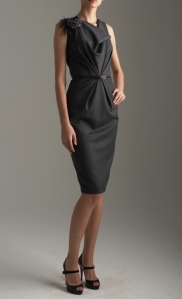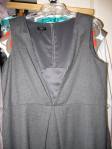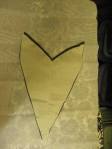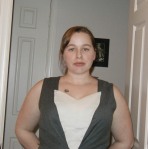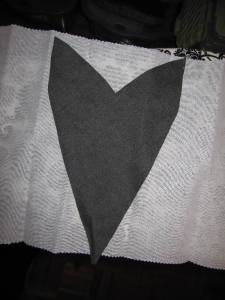Back in Fall 2009, I bought this fabulous charcoal worsted wool Talbots sheath. I loved the angled center bodice and skirt pleats, and in fact have since found a Vogue Ann Klein dress pattern with very similar pleating so I can make some more in this style. Another element I loved about the original dress was a very architectural neckline drape that was formed by a bias-cut bodice insert. On the model it looked fantastic—as garments usually do. See how nicely it lays? (ignore the feathery pin thing on the model—it’s not part of the dress.)
I loved it when I tried the dress on in the shop, as well, despite the extra material making my bust look a bit—well, baggy. I plunked down my money for it and felt very satisfied with my purchase. Sometimes you just have to buck pure figure flattery for something that’s interesting. My mother was with me at the time and she loved it so much she tried one on and bought it as well. Being small-busted (way smaller than me!), this dress works better on her. But even she now finds the drapey center panel annoying, as it won’t lay consistently unless it’s pinned.
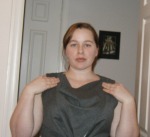
The drape panel was already unpicked here, but you can see the general effect. See how happy I look?
Even with pinning, my bust looks baggy in this dress. It doesn’t lay well under cardigans or jackets, either. But I still love the overall effect of the dress, and have worn it many times. However, I recently came to the conclusion that I’m no longer so in love with the interesting detail that initially was so key to my purchase.
So I decided to refashion the neckline.
This is no easy task, and there’s a significant amount of risk in taking a RTW dress apart—even partially—and attempting such a change. But I’m willing to take it on, because otherwise, I’d get very little use out of this dress in future.
I spent much of this past Saturday morning picking apart the seams where the center drape panel—a bias-cut triangle—joins the main bodice pieces. This was difficult because the bodice and skirt pleats are also made in the same general area. I had to take the dress apart at the center waist seam, as well, because the point of the fabric triangle ends within the waist seam allowance. There’s also a separate lining insert under the drapey panel that holds the main bodice pieces taut—a kind of fabric “stay”. That came out with the stitches holding the panel in place, and it was the first thing to get stitched back in place (carefully, by hand) so I could effectively play around with new bodice insert shapes.
Once the disassembly and restitching of the stay-insert was done, the fun of drafting new neckline shape ideas started. It took me a while prior to starting this project to decide on my goals for the refashion. I want the new center panel to lay flat, to eliminate that extra fullness in the bust that the drape created. I also want a sharp sweetheart style neckline.
I came up with a shape that’s very modern in effect, in keeping with the lines of the dress. It looks, when unfolded, like a very tall, narrow heart with sharply angled peaks, rather than softly rounded ones. The new bodice insert is narrower than the original and has a lower neckline. The original drape was a variation on a high boat-neck. Because of the way the main bodice pieces attached to the drape panel, it will be easy to insert this new panel with the lower neckline while retaining the original seamlines.
I played around with the shape a bit, putting on the dress and pinning the muslin panel in place to see how it should lay and what alterations needed to be made. Surprisingly, very little needed to be done between the first muslin cut and the recut of the original panel.
So now I’ve got a new center panel all ready to install in my Talbots sheath to make it even more wearable for next Fall/Winter. Still undecided as to whether I’ll attempt to machine sew the panel in place (probably not) or affix it using a hand backstitch (probably). The waistline, however, will need to be machine sewn.

